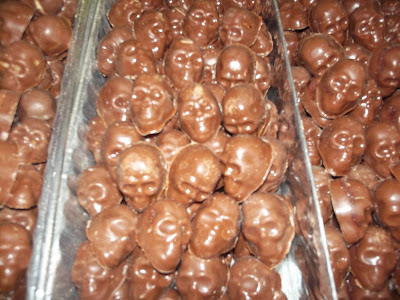**This blog is not endorsed by the U.S. Department of State or COMEXUS.**
They say a picture is worth a thousand words-- a piece of advice that has been proven true by photojournalists throughout the ages. "They" also say a lot of other useful things, like "look both ways before you cross the street" and "don't eat food that you find on the floor" and "don't trust a man with a second head on the back of his real head."
In my last post on the local market, I wrote approximately a thousand words attempting to describe the "ragtag majesty" of a place which effortlessly became one of my two favorite spots in Toluca (the other being a park which I will hopefully write about soon). But the post was woefully short on photos, and so it was a bit hard to picture the colorful things I wrote about.
To remedy that, I took a ton of photos while I was in the market buying supplies to make lentil soup (Fart Alert), which I will use to illustrate the "simultaneously beautiful and frightening patchwork of colors, shapes, and health code violations" that makes up the local market.
Let's start with a (literal) overview:
I made this picture really big so we could do a little game of "I Spy."
In the above picture, can you find:
- Several dolphins leaping gracefully out of the water?
- A pilgrim?
- Two beer bottles?
- Cow stomach?
- Waldo?
Believe it or not, all of the above can be found in the photo. LOOK CLOSELY.
Now we will move into the particulars of the market.
This is the vendor where I buy my lentils (Fart Alert) and oats.
Upon closer inspection, the colored circles reveal some foods that are not typically sold in the U.S. (at least in bulk):
Red circle: Whole sticks of cinnamon
Orange circle: Dried shrimp
Pink circle: Tamarind (a fruit used to make homemade juices)
Blue circle: Dried hibiscus flower, boiled in water to make tea
Green circle x 4: Dried chile peppers. SO MANY CHILE PEPPERS
This is where I buy my onions, potatoes, and carrots (and nothing else, because I know what I like and I buy ONLY THAT). Today I bought two onions, six carrots, and a potato to make lentil soup (Fart Alert) which cost me about one dollar total.
This is where I buy my fruit.
$70 FOR A KILOGRAM OF KIWIS?? What has this world come to? Never mind that it's 50 bucks for freakin' APPLES!!
^ That is probably what you were thinking when you looked at this picture. What you forgot to take into account was that the U.S. dollar and the Mexican peso both use the same symbol ($), so you are actually looking at red apples that cost $2.50 USD per kilo and kiwi fruit that's a whopping $3.50 USD per kilo (which is pretty expensive for Mexico).
This is a flower stall.
This is a booth that sells (among other things) semi-ligitimate mystical cures for semi-legitimate sicknesses (e.g. hair loss). Also sells candles and dried herbs for making teas.
This is a basket shop.
Just look at all those baskets.
This is a plumbing stall. Not much more to say here.
I have, of course, saved the JUCIEST parts of the market for last. Perhaps you have noticed that my photos so far have been suspiciously absent of MEAT. This is because the meat department of the market is the most drastically different from anything we have in the United States, and so is the most shocking.
We'll start off nice and slow:
Based on the size, I think those must be cow feet. And, by extension, cow brains.
On the right side of the styrofoam tray: bull testicles.
On the left side: Props for Left 4 Dead live action version, set to release in Fall 2017. Pre-order now to reserve your copy
Chicky feets
When I asked this man if I could take a picture of his chickens he asked, "Do you want the chicken with or without a helmet on?" Then he put a motorcycle helmet on the dead upside-down chicken, and I was too slow to get a picture. #WillRegretForAllMyLife
"Darnit Irma, I said just a bit off the top"
And I'm sure you'll all waiting for the pig heads, which I enticingly put in the title of this post to entice you. Well, I was unable to find any raw pig heads today.
So you'll just have to do with these boiled ones:
This little piggy had roast beef
This little piggy had none
This little piggy went to market
AND NEVER CAME BACK HOME
So, that's about it. What are your thoughts about the type of markets found in much of Latin America? Would you like to shop here?
P.S. Waldo was not in the picture


























































